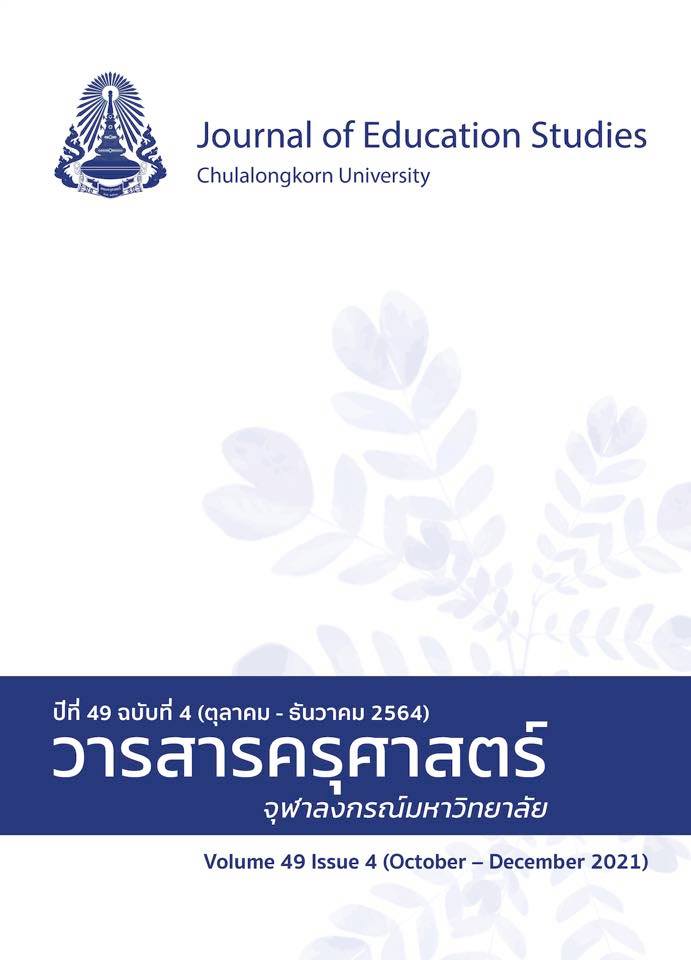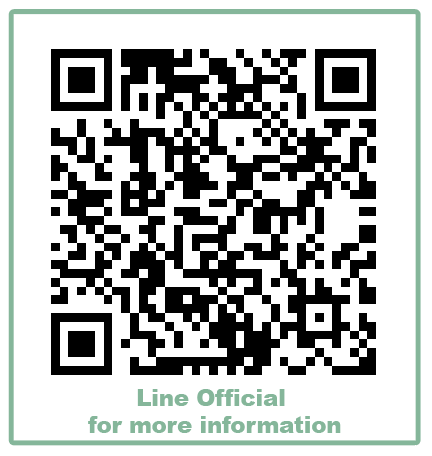กระบวนการสอนและการเรียนรู้กิจกรรมทางกายของผู้สูงอายุในอำเภอกำแพงแสน จังหวัดนครปฐม
DOI:
https://doi.org/10.14456/educu.2021.76คำสำคัญ:
กระบวนการสอน, กระบวนการเรียนรู้, กิจกรรมทางกาย, ผู้สูงอายุพฤฒิพลังบทคัดย่อ
การเรียนรู้กิจกรรมทางกายมีความสำคัญต่อการปรับปรุงการทำหน้าที่ทางกายสำหรับผู้สูงอายุ ช่วยทำให้ดำเนินชีวิตอย่างมีสุขภาพดี การวิจัยครั้งนี้เป็นการวิจัยแบบผสมผสาน มีวัตถุประสงค์เพื่อศึกษากระบวนการสอน และการเรียนรู้กิจกรรมทางกายของผู้สูงอายุ อำเภอกำแพงแสน จังหวัดนครปฐม กลุ่มตัวอย่างเลือกแบบเจาะจง จากผู้สูงอายุพฤฒิพลัง อายุ 60 ปี ขึ้นไป จำนวน 30 คน ลงทะเบียนอบรมในหลักสูตรกิจกรรมทางกายแบบองค์รวม ณ คณะศึกษาศาสตร์และพัฒนศาสตร์ มหาวิทยาลัยเกษตรศาสตร์ ระหว่างเดือนมกราคม–มีนาคม 2562 เครื่องมือวิจัย ได้แก่ แบบสัมภาษณ์กึ่งโครงสร้าง แบบสอบถามความพึงพอใจต่อกระบวนสอนและการเรียนรู้ และแบบทดสอบความรู้ด้านทักษะกิจกรรมทางกาย วิเคราะห์ข้อมูลเชิงคุณภาพโดยจำแนก จัดกลุ่มข้อมูล วิเคราะห์องค์ประกอบ สรุปแบบอุปนัย วิเคราะห์ข้อมูลเชิงปริมาณโดยหาค่าเฉลี่ย ส่วนเบี่ยงเบนมาตรฐาน ทดสอบความแตกต่างของคะแนนก่อนและหลังการเรียนรู้ ด้วยสถิติ paired t–test ผลการวิจัย พบว่า กระบวนการสอนและการเรียนรู้กิจกรรมทางกายผู้สูงอายุ มุ่งเน้นทักษะป้องกันหกล้ม ข้อเข่า สมองเสื่อม และประเมินสมรรถภาพการทำหน้าที่ทางกาย กลวิธีสร้างสุข สนุกสนาน แรงจูงใจหลายรูปแบบจัดสภาพแวดล้อมทั้งสถานที่ สื่อคอมพิวเตอร์ที่เหมาะสม ผลการสังเคราะห์กระบวนการสอนและการเรียนรู้ 5 องค์ประกอบ คือ 1) เคลื่อนไหวด้วยความสนุก 2) เรียนรู้แบบกลุ่ม 3) เชื่อมโยงประสบการณ์ 4) แรงจูงใจจากภายในและภายนอก 5) ความสุขในความสำเร็จแห่งตน เสนอแนะให้สถานศึกษาพัฒนาระบบการเรียนรู้กิจกรรมทางกายสำหรับผู้สูงอายุ ทั้งหลักสูตร การสอน และการประเมินผล
References
มูลนิธิสถาบันวิจัยและพัฒนาผู้สูงอายุไทย. (2559). รายงานประจำปี สถานการณ์ผู้สูงอายุไทย ประจำปี 2560. มูลนิธิ
สถาบันวิจัยและพัฒนาผู้สูงอายุไทย. https://thaitgri.org/?p=38427
มูลนิธิสถาบันวิจัยและพัฒนาผู้สูงอายุไทย. (2561). รายงานประจำปี สถานการณ์ผู้สูงอายุไทย ประจำปี 2560. มูลนิธิ
สถาบันวิจัยและพัฒนาผู้สูงอายุไทย. https://thaitgri.org/?p=38607
ฐิติมา ดวงวันทอง. (2560). การเรียนรู้สำหรับผู้สูงอายุ [วิทยานิพนธ์ปริญญามหาบัณฑิต ที่ไม่ได้ตีพิมพ์]. มหาวิทยาลัยศรีปทุม.
สุธีรา บัวทอม, สุทธิพงศ์ สภาพอัตถ์, และ ศิริณา จิตต์จรัส. (2558). ผู้สูงอายุกับเหตุผลในการเรียนรู้ วิธีการเรียนรู้ และสิ่งที่ต้องการเรียนรู้. วารสารศึกษาศาสตร์ มหาวิทยาลัยศิลปากร, 12(1,2), 6-17.
สำนักงานสาธารณสุขอำเภอกำแพงแสน. (2562). รายงานสถิติ ประจำปีงบประมาณ พ.ศ. 2562. ม.ป.ม.
อาชัญญา รัตนอุบล. (2562). ข้อเสนอการพัฒนาการดำเนินงานส่งเสริมศักยภาพผู้สูงอายุ. วารสารศิลปากรศึกษาศาสตร์วิจัย,
11(1) (มกราคม–มิถุนายน), 26–46.
อัจฉรา ปุราคม. (2559). การส่งเสริมกิจกรรมทางกายเพื่อสุขภาพผู้สูงอายุ (พิมพ์ครั้งที่ 2). เพชรเกษมการพิมพ์.
อัจฉรา ปุราคม, ศิริชัย ศรีพรหม, ธารินทร์ ก้านเหลือง, และ ธีระศักดิ์ สร้อยคีรี. (2560). การพัฒนาหลักสูตรกิจกรรมทางกาย
ผู้สูงอายุแบบองค์รวม. Veridian E–journal, Silpakorn University ฉบับภาษาไทย สาขามนุษยศาสตร์
สังคมศาสตร์ และศิลปะ, 11 (3), 2013–2030.
ภาษาอังกฤษ
Arsenault, N. & Anderson, G. (1998). New learning horizons for older adults. Journal of Physical Education, Recreation and Dance, 69(3), 27–31. https://www.tandfonline.com/doi/abs/10.1080/07303084.
1998.10605088
Ardelt, M. (2000). Intellectual versus wisdom–related knowledge: The case for a different kind of learning in
the later years of life. Educational Gerontology, 26, 771–789.
Barton, H. (1999). Effects of international program on the attitudes of emotionally disturbed youth toward the elderly. Educational Gerontology, 25, 623–640.
Brawley, L. R., Rejesky, J. & King, A. C. (2003). Promoting physical activity for older adults: The challenges
for changing behavior. American Journal of Preventive Medicine, 25(3), Supplement 2,
172–183. https://www.sciencedirect.com/science/article/abs/pii/S074937970300182X
Chaffin, A. J., & Harlow, S. D. (2005). Cognitive learning applied to older adult learners and technology.
Educational Gerontology, 31(4), 301–329. https://www.tandfonline.com/doi/abs/10.1080/
03601270590916803.
Findsen, B. (2005). Learning later. Krieger Publishing Co.
Findsen, B. & Formosa, M. (2011). Lifelong learning in later life: A handbook on older adult learning. Sense Publishers.
Jarvis, P. (1992). Paradoxes of learning: On becoming on individual in society. Jossey–Bass.
Johnson, et al. (2016). Light physical activity is positively associated with cognitive
performance in older community dwelling adults. Journal of Science and Medicine in
Sport, 19(11), 877–882. https://pubmed.ncbi.nlm.nih.gov/26922133/
Formosa, M. (2002) Critical gerogogy: Developing practical possibilities for critical educational gerontology. Education and Ageing, 17(3), 73–86.
Formosa, M. (2010). Older adult learning in Malta: Towards a policy agenda. Mediterranean Journal of Educational Studie, 15(1), 61–85.
Formosa, M. (2011). Critical educational gerontology: A third statement of first principles. International Journal of Education and Ageing, 2(1), 317–300. https://core.ac.uk/download/pdf/46602367.pdf.
Gray, H. (1999). Is there a theory of learning for older people?. Research in Post–Compulsory Education, 4(2).
Harvey, J., Chastin, S., & Skelton, D. (2013). Prevalence of sedentary behavior in older adults: A systematic review. International Environment Research Public Health, 10(12), 6645–6661. https://pubmed.ncbi.nlm.nih.gov/24317382/
Horm, J. L., & Hofer, S. M. (1992). Major abilities and development in the adult period. In R. J. Sternberg & C. A. Berg (Eds.), Intellectual development: Cambridge University Press.
Jimenez–Zazo, F., Castro–Lemus, N., Dorado–Suarex, & A., Aznar, S. (2020). Transtheoretical
model for physical activity in older adults: Systematic review. International Journal
Environment Research Public Health, 17(24), 9262. https://pubmed.ncbi.nlm.nih.gov/33322327/
Jones & Rose. (2005). Physical activity instruction of older adults. Human kinetics.
Maderer & Skiba. (2006). Integrative geragogy: Part 1: Theory and practice of a basic model. Education Gerontology, 32(2), 125–145. https://www.tandfonline.com/doi/abs/10.1080/03601270500388158
McMullan, I., Bunting, B. P., McDonough, S. M., Tully, M. A. & Casson, K. (2020). The
association between light intensity physical activity with gait speed in older adults (≥ 50 years). A longitudinal analysis using the English Longitudinal Study of Ageing (ELSA). Aging Clinical Experimental Research, 32(11), 2279–2285. https://pubmed.ncbi.nlm.nih.gov/31925725/
McPhee, J. S., French, D. P., Jackson, D. J., Naxroo, J., Pendleton, N., & Degens. (2016). Physical
activity in older age: Perspectives for healthy ageing and frailty. Biogerontology, 17,
567–580. https://www.ncbi.nlm.nih.gov/pmc/articles/PMC4889622/.
O'Brien, M. W., Robinson, S., Frayne, R., Mekary, S., Fowles, J. R., & Kimmerly, D. S. (2018).
Achieving Canadian physical activity guidelines is associated with better vascular function independent of aerobic fitness and sedentary time in older adults. Apply Physiology Nutrition & Metabolism, 43(10), 1003–1009. https://pubmed.ncbi.nlm.nih.gov/29671330/
Os, Y. V., Vugt, M. E., & Boxtel, M. V. (2015). Cognitive interventions in older persons: Do they change the
functioning of the brain?. Journal of Biomedicine Research International, 25(1), 1–14. doi:
10.1155/2015/438908
Purakom, A. (2015). Association between sedentary behaviour and cardio–metabolic risk in Thai active
older adults. 1st ACPES conference, Indonesia.
Sjöström et al. (2006). Health–enhancing physical activity across European Union countries: The eurobarometer study. Journal of Public Health, 14(1), 1–10.
Sanjuan, M., Navaro, E. & Carelo, M. D., (2020). Effectiveness of cognitive Interventions in older adults:
A review. European Journal of Investigation in Health, Phycology and Education, 10(3), 876-898.
Willis, S .L., & Schaie, K. W. (2006). A constructionist view of the third age: The case of cognition. Annual
Review of Gerontology and Geriatrics, 26, 131–151.
World Health Organization [WHO]. (1999). The implications for training of embracing a life course
approach to health. Geneva: Switzerland. https://www.who.int/ageing/publications/
lifecourse/alc_lifecourse_training_en.pdf
World Health Organization [WHO]. (2002). Global physical activity surveillance. World Health Organization.
World Health Organization [WHO]. (2020). Global recommendations on physical activity for heath.
World Health Organization.
Zubala, et al. (2017). Promotion physical activity intervention for community dwelling older adult: A
systemic review of reviews, PLOS ONE, 12(7), e0180902. https://pubmed.ncbi.nlm.nih.gov/
28700754/.
Downloads
เผยแพร่แล้ว
How to Cite
ฉบับ
บท
License

This work is licensed under a Creative Commons Attribution-NonCommercial-NoDerivatives 4.0 International License.



